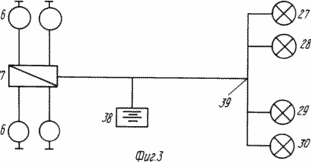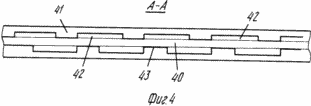| Start of section
Production, amateur Radio amateurs Aircraft model, rocket-model Useful, entertaining |
Stealth Master
Electronics Physics Technologies Inventions |
Secrets of the cosmos
Secrets of the Earth Secrets of the Ocean Tricks Map of section |
|
| Use of the site materials is allowed subject to the link (for websites - hyperlinks) | |||
Navigation: => |
Home / Patent catalog / Catalog section / Back / |
|
INVENTION
Patent of the Russian Federation RU2013658
![]()
ENERGY INSTALLATION
The name of the inventor: Handel EG; Handel VA
The name of the patent owner: Handel Yevgeny Grigorievich
Address for correspondence:
Date of commencement of the patent: 1990.11.29
Use: as an environmentally friendly source of electricity for various devices. SUMMARY OF THE INVENTION: The plant includes a solar heater, a solar collector, a thermal heater, a device for external heating of a working gas under a predetermined pres- sure, and an energy converter configured as a two-chamber bellows with a movable sealed partition in the middle having a rod connected to the rack- Handwheel mechanism and electric generator. The helium heater, thermal heater and energy converter are executed in pairs in strict symmetry and are connected to each other by connecting chambers having blinds alternately passing working gas from the first part of the device, then from the second one. This working gas drives the separator with a rod back and forth. The power converter is made in the form of a bellows with a movable partition and a rod. The helium heater and the heat heater are divided into two separate parts, the first parts of which are connected to the second chambers, the walls of which are made in the form of drive louvers. An energy converter is one for both a helium heater operating from solar radiation and a thermal heater operating from an external heat supply.
DESCRIPTION OF THE INVENTION
The invention relates to small-scale power engineering and can be widely used as an environmentally friendly source of electricity for powering various devices.
There are known Stirling engines, driven from sources of external heat input in the combustion of fuel (heaters). Solar power stations are also known that use solar radiation through the solar collector to heat the heat carrier, for example, the working gas, and convert the energy of the coolant into mechanical or electrical energy (helium heaters).
The closest thing to the invention is in terms of the number of common features and technical essence of the power plant, which has interconnected energy sources - helium heater and thermal heater. The heated low-pressure working gas passes through the compressor, where its pressure rises, and then to the power converter in the form of a turbine with an electric generator. The device has connecting elements, electronic control and a cooler. However, the known device is not constructively compact and not efficient enough.
To increase the efficiency of the device containing interconnected helium heater, thermal heater, energy converter and connecting chamber, filled with working gas, cooler, electronic control system for their operation and its actuators, the power converter is equipped with a rod and a movable partition wall. The helium heater, the thermal heater, the energy converter and the connecting chamber consist of two separate parts, the first parts of which are connected to the first part of the connecting chamber through the actuating elements of the control system, made as drive louver, and the second parts to the second part of the connection chamber. The parts of the energy converter are made in the form of two nonmetallic bellows, hermetically connected to the dividing wall and kinematically - with the rod of the energy converter and made with the possibility of changing the internal volume and the external heat exchange surface, the cooler in the form of a container with water in which the bellows of the energy converter are placed.
 |
 |
 | |
 |
In Fig. 1 shows the device, a front view; In Fig. 2 - diagram of the drive louvre; In Fig. 3 - device control scheme; In Fig. 4 is a section AA in Fig. 1.
The heater 1 consists of the left solar collector 2, the right solar collector 3, the panels of the insulating glass unit 4, which are supported from the inside by a cellular metal frame 5 and have external pressure gauges with pressure sensors 6, working gas 7 heated by the sun 8. The heater 9 is divided into a left heater 10 and a right heater 11 heated by external combustion sources 12. The power converter 13 consists of a pool 14 with water 15 and a bellows-cooler 16 fitted therein having a working separator 17, a rod 18, a stop 19, and a bellows chambers 21 , Which are closed by the left grate 22 and the right grate 23, which have magnets 24 and go to the left 25 and right 26 connecting chambers, on which the left 27 and right 28 helio-actuated blinds, left 29 and right 30 thermal drive louvers.
The drive blinds (the design of all the blinds are identical) consist of a rail with a rod 31 connected to a tension spring 32 operatively connected to electromagnets 33 and toothed hinges 34 mounted on frame 35 which has tabs 36.
The basic scheme for controlling the operation of the device includes a computer 37, a charging unit 38, control circuits with actuators 39.
The insulating glass panel consists of smooth glass 40, corrugated glass 41, vacuum cavities 42, sealant 43.
DEVICE WORKS AS FOLLOWING
In solar weather, helium heater 1 is functioning, and the heater 9 is turned off. The working gas 7 in the cold state in the left solar collector 2 receives solar energy from the sun 8 through the panels of the double-glazed unit 4 and heats up in a confined space, its pressure increases and all parameters change according to the isochoric process. The left helio-drive blind 27 is de-energized, closed, its electromagnet 33 is de-energized. When the pressure of the working gas 7 rises to the level of the pressure of the pressure gauge with the sensor 6, the computer 37 turns on the electromagnets 33. The left 27 and then the right 28 helio-actuator louvres open and the working gas 7 rushes through the left connecting chamber 25 to the left bellows chamber 20, The separator 17, having come off its stop 19 from the magnets 24, comes into reciprocating motion together with the rod 18, and the cooled working gas 7 with the dropped pressure in the right bellows chamber 21 is pushed into the right solar collector 3. When the working separator 17 Of the right grate 23, the abutments 19 close with the magnet 24 and the command from the computer 37 closes the left 27 and right 28 helio shutters by de-energizing the electromagnets 33 and triggering the tension springs 32. The process is then repeated.
During night and overcast weather, heater 1 is switched off, the heater 9 is switched on. The heli-drive blinds are de-energized, closed and do not work. Thermal drive shutters are provided with power from the charging unit 38 and are included in the operation. The working gas 7 is heated alternately in the left heater 10, then in the right heater 11, its pressure rises until the manometer with the sensor 6 is turned on, and then alternately through the left, then through the right connecting chamber, the working gas enters either the left or right bellows Camera, performing work identical to its work in the gel heater.
CLAIM
ENERGY INSTALLATION, containing interconnected helium heater, thermal heater, energy converter and connecting chamber, filled with working gas, cooler, electronic control system for their operation and its actuators, characterized in that the energy converter is equipped with a rod and movable partition wall, helio heater, thermal heater, energy converter and connecting chamber Consists of two separate parts, the first parts of which are connected to the first part of the connecting chamber through the actuating elements of the control system, made in the form of drive louvers, and the second parts to the second part of the connecting chamber, the parts of the energy converter being made in the form of two nonmetallic bellows sealed to Separating partition, kinematically - with the rod of the energy converter, and made with the possibility of changing the internal volume and the external heat exchange surface, the cooler in the form of a container with water in which the bellows of the energy converter are placed.
print version
Published on February 13, 2007




Comments
When commenting on, remember that the content and tone of your message can hurt the feelings of real people, show respect and tolerance to your interlocutors even if you do not share their opinion, your behavior in the conditions of freedom of expression and anonymity provided by the Internet, changes Not only virtual, but also the real world. All comments are hidden from the index, spam is controlled.